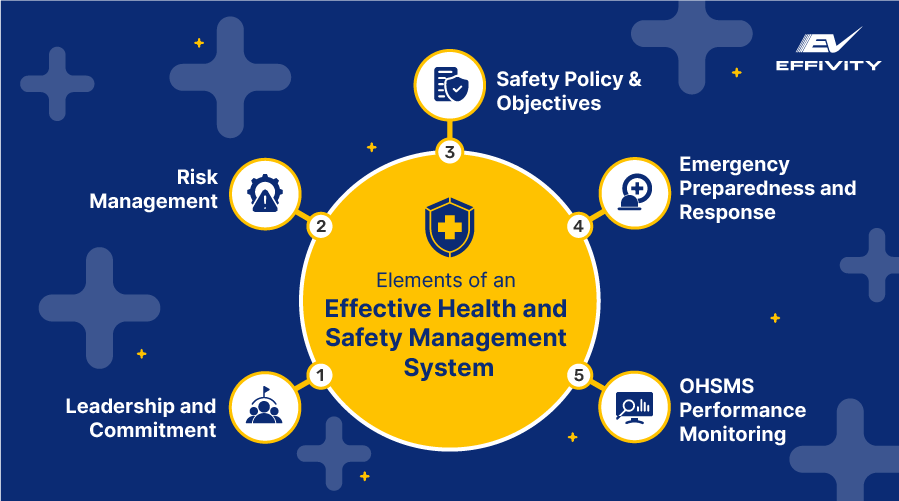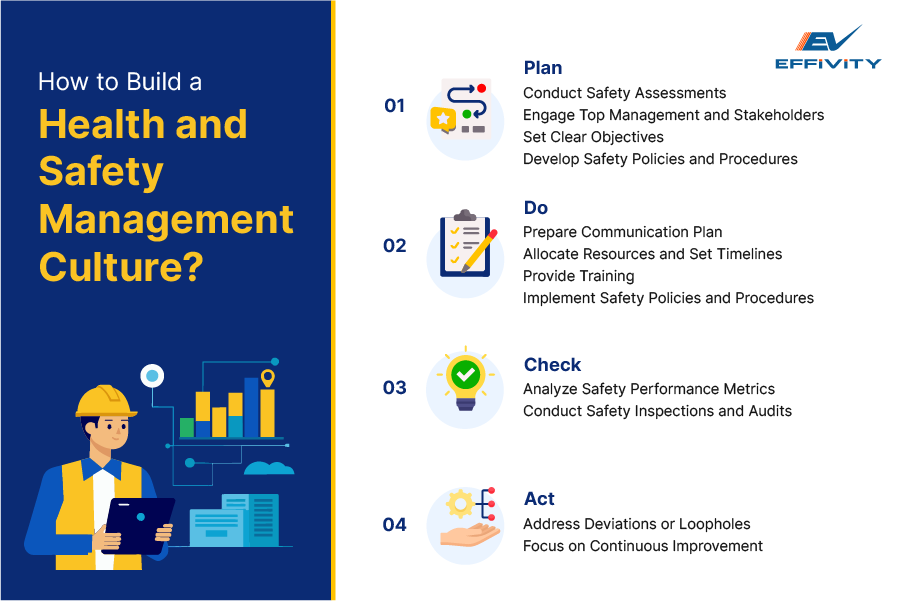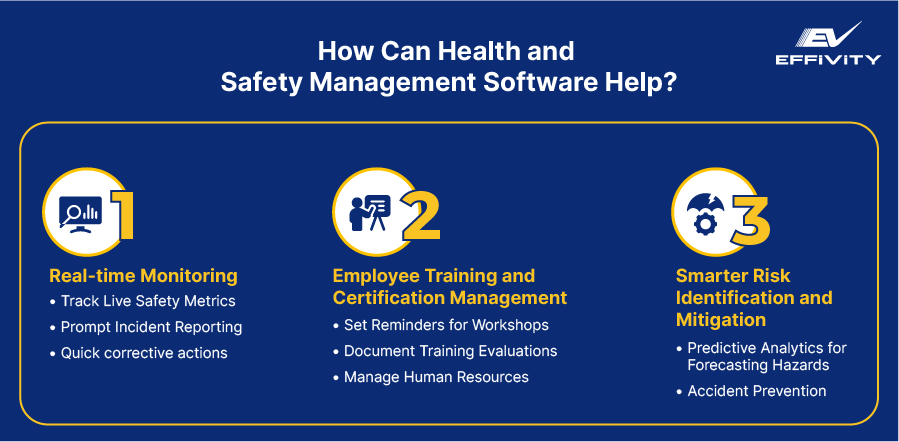In 2022, a worker died every 96 minutes due to a work-related hazard. That's the grim reality of today's workplace across numerous industries.
And it's not just the fatalities that concern an organization. Non-fatal accidents and exposure to toxic elements can have equally dire consequences. These include absent labor, hampered productivity, financial hiccups, and legal liabilities.
Health and safety management plays a key role in preventing workplace accidents and injuries. It's not just an ethical checkbox, but a cornerstone for every successful business.
In this blog, we’ll dig deeper into the concept of a health and safety management system—its definition, basic components, and significance. You’ll also learn about safety culture promotion and the need for OHSMS software.
Why is Health and Safety Management System Mandatory?
- What is Health and Safety Management?
- Elements of an Effective Health and Safety Management System
- Can you survive without a result-oriented occupational health & safety system?
- Building a Health and Safety Management Culture in the Workplace
- Challenges with Traditional Health and Safety Management Systems
- How Can Health and Safety Management Software Help?
- 3 Must-have Features in an Ideal Health and Safety Management Software
- Frequently Asked Questions (FAQs)
What is Health and Safety Management?
Health and safety management refers to the process of prioritizing and planning for employee well-being. The primary goal is to reduce accidents and injuries in the workplace so that you provide a healthy and safe environment for the employees.
A health and safety management system, thus, is a systematic approach to fostering this culture in the workplace.
This includes assessing and mitigating risks, implementing accident prevention measures, educating employees regarding their safety, etc.
Elements of an Effective Health and Safety Management System
Given below are the 5 most essential elements that every occupational health and safety management system (OHSMS) must have:

1. Leadership and Commitment
Leadership plays a defining role in setting the order for health and safety management. This involves securing a commitment from the top management and leading by example.
In addition, you must follow the protocols as per the health and safety management system, actively participate in training, and have an open-door policy to address employee concerns.
2. Risk Management
Proper risk management is vital for preventing workplace accidents and injuries. It comprises of:
a. Hazard Identification
By identifying hazards, businesses can look out for potential accidents and nip them in the bud. For example, broken equipment that could hurt someone, toxic fumes, etc.
b. Risk Assessment
It's crucial to categorize risks based on the threat level and the likelihood of impact to address severe risks first.
c. Risk Mitigation
There are different ways to mitigate risks depending upon their nature. For example, reduction, avoidance, transference, and acceptance.
3. Safety Policy & Objectives
A safety policy sets forth the expectations from the health and safety management system so that everyone in the organization is on the same page. It demonstrates strong leadership commitment while acting as the backbone for risk management and legal compliance.
4. Emergency Preparedness and Response
Life is uncertain. Accidents can take place even after rigorous planning. Maybe an employee neglected a certain protocol or a natural calamity took place.
Hence, it's always better to have emergency preparedness protocols to minimize the impact of the incident through quick and effective action.
5. OHSMS Performance Monitoring
Continuous monitoring is essential for detecting early problems and finding loopholes within the health and safety management system. This promotes overall improvement as the business grows with changing requirements.
Can you survive without a result-oriented occupational health & safety system?
While a health and safety management system may not be legally mandatory for every company, in many industries it is mandated by several regulatory requirements including companies working in high risk areas., Either required by a regulation, contractual commitment or a voluntary decision, the design & implementation of an OHSMS plays a pivotal role in deciding the success and reputation of an organization. Let's see how:
1. Employee Well-being
Workplace safety directly affects employee morale and productivity. The more healthy the work environment is, the safer the employees feel.
In fact, through health and safety training programs and workshops, they get the opportunity to learn, engage, and express their concerns.
However, the real importance of a health and safety management system lies in its ability to empower employees. For example, using OHSMS software, they can report incidents, get safety alerts, and communicate in real-time.
2. Ensuring Compliance
Audits and inspections are necessary for building a robust occupational health and safety management system. They help ensure compliance with legal obligations and workplace safety regulations.
Thus, your business steers clear of penalties and fines. This further adds confidence among employees and motivates them to contribute their best.
3. Minimizing Workplace Injuries and Accidents
With a strong focus on risk management, organizations can prevent workplace accidents and injuries to a great extent. For example, you can detect faults in machinery and equipment before the problem escalates into a tragedy.
4. Improving Brand Image
Having an OHSMS in place demonstrates the organization's regard for employee health and safety. This builds credibility and trust among the stakeholders, clients, and the public.
In addition, your organization attracts top talent, retains existing employees, and maintains healthy relationships with customers and vendors.
5. Boosted Productivity
A safe workplace with empowered employees—exactly what you need to ramp up productivity. Organizations with health and safety management systems experience decreased employee absenteeism, fewer risks, and minimal downtime.
Building a Health and Safety Management Culture in the Workplace
So, how do you go about setting up a health and safety management system?
Let's find out!

1. Plan
Start by conducting safety assessments to understand the current situation of your organization. Engage top management and stakeholders to explore different concerns regarding workplace safety, especially those faced by the front-line workers.
Based on the inferences, set clear objectives that you'd like the health and safety management system to achieve. Develop safety policies and procedures that reflect your goals and support all the aspects of an OHSMS—risk management, compliance, employee training, etc.
2. Do
Prepare a communication plan and set up a health and safety committee for a more systematic approach. Allocate resources and set timelines.
Provide training to the employees so that they know their responsibilities. Conduct safety workshops to educate them regarding occupational health standards, and workplace safety regulations.
Implement the set policies and procedures in a phased approach to easily monitor the progress and take necessary corrective actions without losing focus.
3. Check
It's time to track growth and measure the effectiveness of the health and safety management system.
Analyze the safety performance metrics like injury rate, near misses, reported incidents, employee overtime, etc., to understand the evolving workplace atmosphere.
Conduct regular inspections and audits to ensure compliance.
4. Act
Address deviations or loopholes within the system as and when you find them. Develop action plans to strategize how you'll mitigate risks, who'll be responsible, and what resources are required to achieve this.
Focus on continuous improvement—even if there are fewer or zero risks, always watch out for areas to improve. You must be ready to adjust and adapt to emerging trends, unexpected risks, and expanding business.
Challenges with Traditional Health and Safety Management Systems
The traditional way to build and implement a health and safety management system was doing everything manually—risk management, documentation, training, etc.
But today, that comes with its share of troubles:
1. Manual Processes and Human Error
Traditional systems put humans at the core of everything—safety inspections, hazard identification, and so on. This often led to poor calculations, misplaced data, and massive errors.
Not to forget, the entire process was super cumbersome, time-consuming, and inefficient.
2. Lack of Integration and Collaboration
It's tricky to manage processes when everything is on paper. Or even if you're using different systems for different aspects without any scope for integration.
Thus, it becomes difficult for everyone to stay consistent, keep up with varying data, and share collective expertise.
3. Difficulty Tracking Compliance Requirements
Another challenge for traditional health and safety management systems is to stay compliant using manual processes. For example, even if an organization manages to conduct timely audits, the results are highly prone to human error and the process itself is time-consuming.
Plus, the task becomes a nightmare when you factor in multiple sites and documentation management.
4. Poor Data Analysis and Reporting
The biggest drawback of the traditional OHSMS is that it does not support trend analysis and real-time data.
First of all, there's always a delay in fetching the live data and reporting incidents. Second, manually identifying patterns and drawing meaningful insights can be mind-boggling.
How Can Health and Safety Management Software Help?
Organizations can enhance their safety culture using robust OHSMS software. They can easily stay abreast with compliance regulations, manage risks, and even collaborate across departments and systems for comprehensive health and safety management.
Here are the top three reasons why you must invest in OHSMS software:

1. Real-time Monitoring
Accessing live data is crucial for approaching health and safety management correctly. OHSMS software comes with user-friendly dashboards to monitor safety metrics based on real-time data.
Employees can quickly report an incident while following all the risk management protocols. As a result, managers and team leads can take swift preventive measures or corrective actions without wasting time.
2. Employee Training and Certification Management
Using OHSMS software, you can also manage human resources, especially when it comes to training employees.
You can store records of onboarding procedures and training sessions for new employees, set reminders for upcoming workshops, and even document training evaluations.
As a result, you can ensure that your employees are up-to-date with the latest regulations, are completely certified, and possess the right skillset.
3. Smarter Risk Identification and Mitigation
Predictive analytics runs at the core of automated OHSMS software. This facilitates smarter risk management as you can now predict risks beforehand and thus prevent potentially fatal accidents.
For instance, the software can provide a detailed job safety analysis so that no task puts the lives of your employees at stake.
3 Must-have Features in an Ideal Health and Safety Management Software
Here are the top three features that every health and safety management software should have:
1. Mobile Incident Reporting
Every employee must have access to the OHSMS software via a mobile application that can be easily installed on their smartphone. So that they can report incidents in real time, capture photos/videos for documentation, and share live locations for safety purposes.
2. Integration with Safety Equipment
Another striking feature is integration with wearable devices like smart helmets to share employee vitals. You can also connect safety equipment like fire extinguishers with the software to monitor their performance—pressure levels, maintenance, replacement, etc.
3. Interactive Safety Training Modules
Planning fun, informative, and engaging training sessions is possible using OHSMS software that supports gamified learning modules, scenario-based simulations, and interactive quizzes.
Frequently Asked Questions (FAQs)
1.How can organizations assess the effectiveness of the health and safety management system?
Conducting regular audits and inspections is the best way to gauge the effectiveness of the health and safety management system. This helps track key safety metrics like compliance with safety protocols, injury rates, etc.
2.How can small businesses with limited resources implement a health and safety management system?
Small businesses must conduct a safety assessment to prioritize their requirements and build a health and safety management system that strictly aligns with them. You can scale up as your business grows.
3.Are there any international standards for OHSMS?
Yes. ISO 45001 is an international standard that defines the requirements of an ideal OHSMS.
4.Can I implement & maintain an internal standard like ISO 45001 with ease & simplicity?
Yes, very easily. Effivity will make your ISO 45001 implementation and maintenance simple, employee-friendly and always audit-ready.
5.I am required to demonstrate an effective Occupational Health & Safety management system implementation as a part of our supplier registration and contractual obligations. What is the best way to do this?
With Effivity, you can demonstrate to your potential customer during the supplier registration process that you have all the required OHSMS conformities in place and effectively implemented. Our onboarding process and expert OHSMS consultants will ensure you meet the requirements of the standards effectively.





























